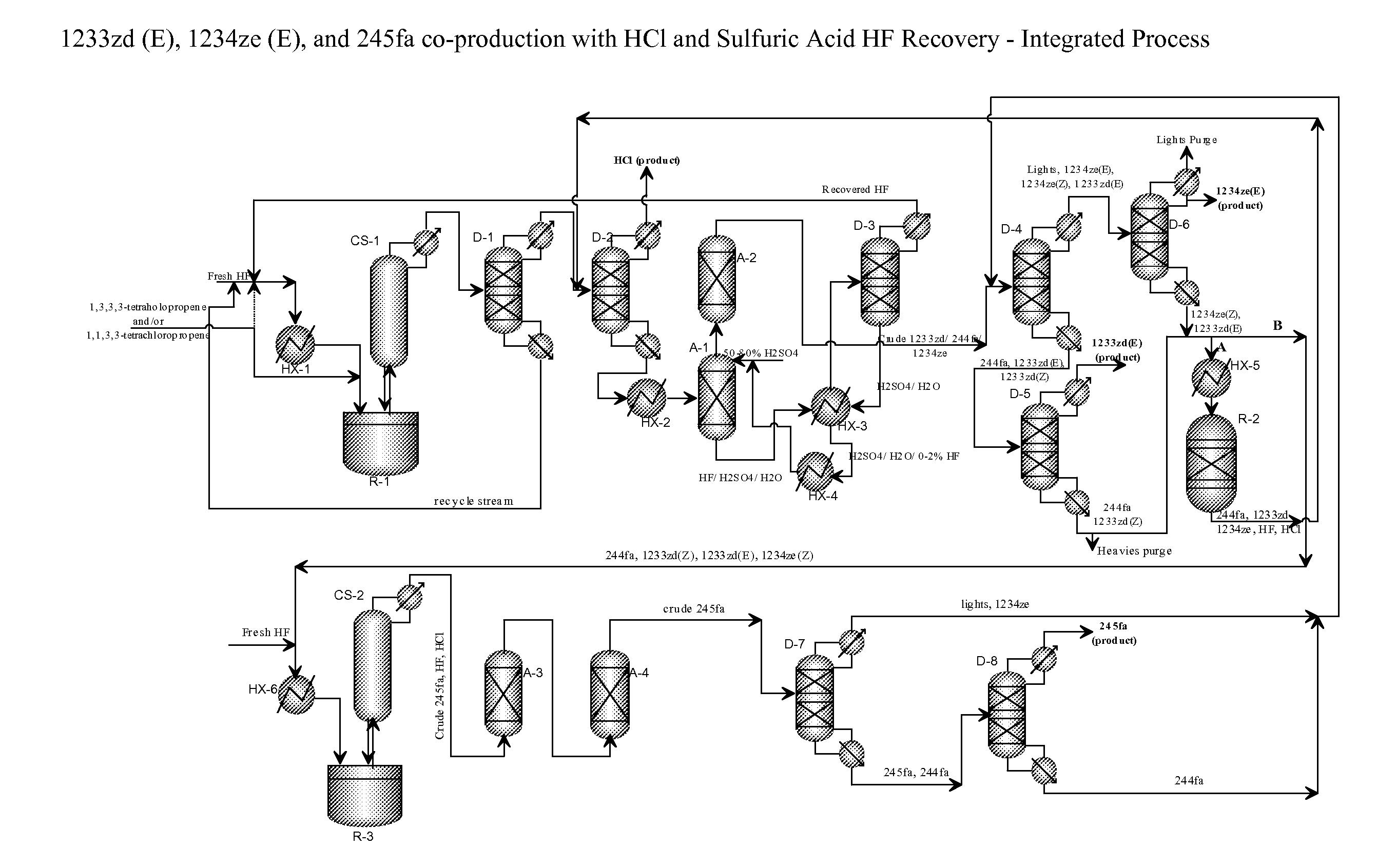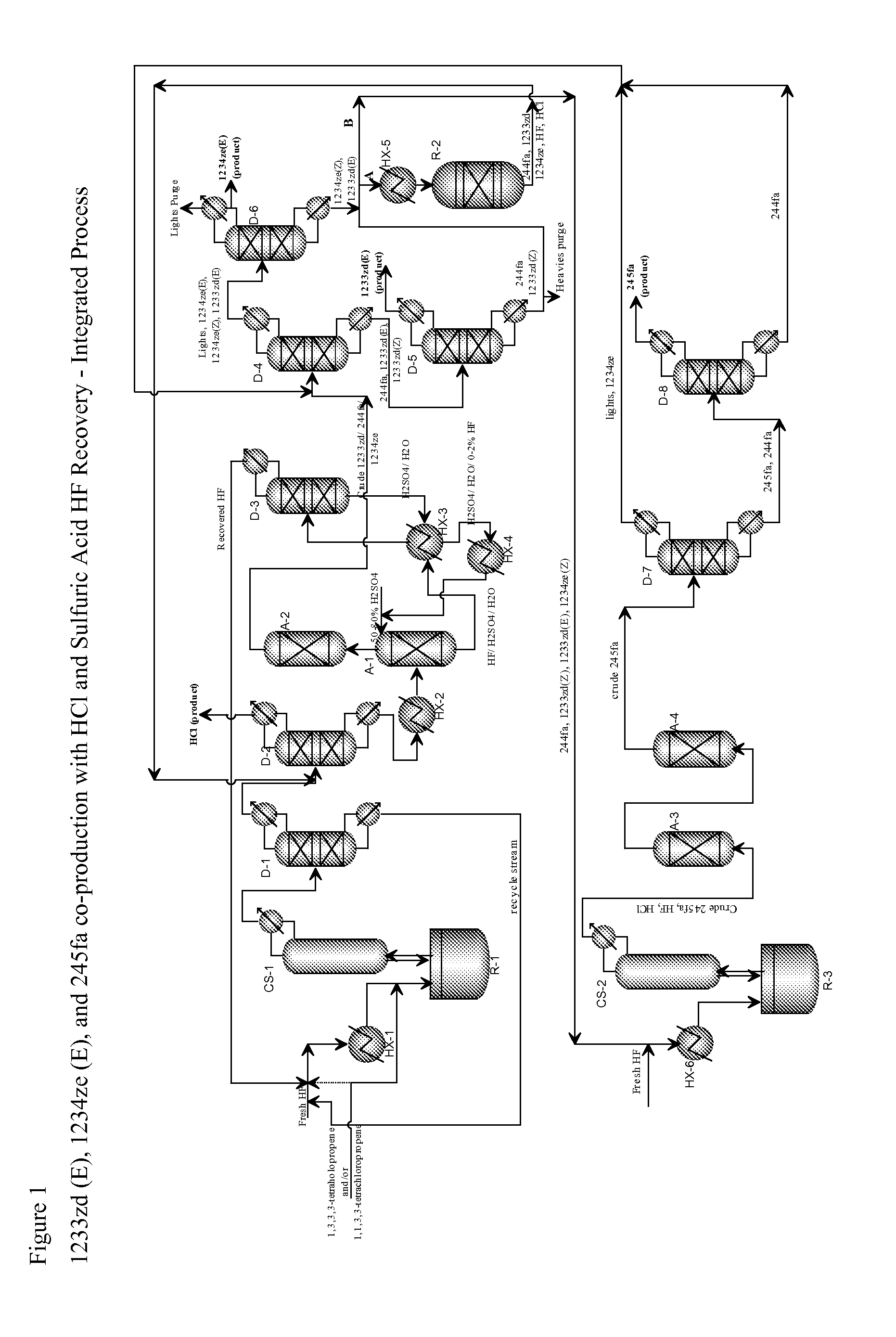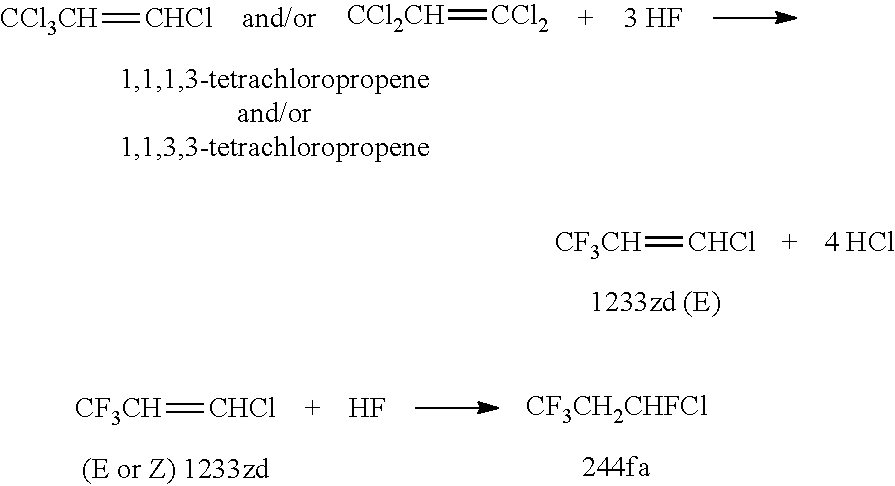Integrated process for the co-production of trans-1-chloro-3,3,3-trifluoropropene, trans-1,3,3,3-tetrafluoropropene, and 1,1,1,3,3-pentafluoropropane
a technology of trifluoropropene and trans-chloro-3,3,3-trifluoropropene, which is applied in the direction of halogenated hydrocarbon preparation, halogenated hydrocarbon separation/purification, hydrogen halide split-off, etc., can solve the need for a continuous economic process and achieve the effect of maximizing raw material utilization and product yield, and great flexibility in producing different amounts
- Summary
- Abstract
- Description
- Claims
- Application Information
AI Technical Summary
Benefits of technology
Problems solved by technology
Method used
Image
Examples
example 1
[0077]This example illustrates the continuous reaction where a mixture of 1,1,1,3-tetrachloropropene and 1,1,3,3-tetrachloropropene is continuously fed into a charge of titanium halide catalyst and HF.
[0078]A clean, empty 10-gallon jacketed, agitated reactor of Hastelloy C construction is prepared. This reactor is connected to a two-inch diameter vertical, PTFE-lined pipe containing packing material (stripper), which is in turn connected to an overhead heat exchanger. The heat exchanger is supplied with −40° C. brine circulation on the shell side. Vapors exiting this stripper are processed through a scrubber, in which temperature-controlled dilute potassium hydroxide aqueous solution is circulated. Vapors exiting this stripper are collected in a weighed, chilled (−40° C.) cylinder, followed by a smaller cylinder in series chilled in a dry ice bath.
[0079]Initially about 1500 grams lbs of TiCl4 is added as a catalyst, followed immediately by 30 lbs of HF. The reactor contents are heat...
example 2
[0080]This example illustrates the semi-batch reaction where a mixture of 1,1,1,3-tetrachloropropene and 1,1,3,3-tetrachloropropene is continuously fed into a charge of titanium halide catalyst and HF.
[0081]The same reactor as in Example 1 is used. The reactor is charged with 2500 grams of fresh TiCl4 catalyst. The intent of the experiment is actually to produce 1233zd (E) with high selectivity.
[0082]The process (reaction of 1,1,1,3-tetrachloropropene and 1,1,3,3-tetrachloro-propene+HF in the presence of TiCl4 catalyst) is changed from a completely batch process to a semi-batch process to reduce the residence time of 1,1,1,3-tetrachloro-propene and 1,1,3,3-tetrachloropropene which will reduce the formation of the over fluorinated species, 244fa. The reactor is initially charged with 50 lbs of HF followed by 13 lbs of a mixture of 1,1,1,3-tetrachloropropene and 1,1,3,3-tetrachloropropene. The reactor temperature is slowly increased and reaction is observed at about 82° C. to 85° C.
[0...
example 3
[0085]This example (called Run #3) illustrates the semi-batch reaction where HF is continuously fed into a charge of titanium tetrachloride catalyst and a mixture of 1,1,1,3-tetrachloropropene and 1,1,3,3-tetrachloropropene.
[0086]A clean, empty 10-gallon jacketed, agitated reactor of Hastelloy C construction is prepared. This reactor is connected to a 2 inch diameter vertical, PTFE-lined pipe containing packing material (stripper), which is in turn connected to an overhead heat exchanger. The heat exchanger is supplied with −40° C. brine circulation on the shell side. Vapors exiting this stripper are processed through a scrubber, in which temperature-controlled dilute potassium hydroxide aqueous solution is circulated. Vapors exiting this stripper are collected in a weighed, chilled (−40° C.) cylinder referred to as the product collection cylinder (PCC), followed by a smaller cylinder in series chilled in a dry ice bath.
[0087]For the experiment, 14 lbs of anhydrous HF is charged to ...
PUM
| Property | Measurement | Unit |
|---|---|---|
| Fraction | aaaaa | aaaaa |
Abstract
Description
Claims
Application Information
 Login to View More
Login to View More - R&D
- Intellectual Property
- Life Sciences
- Materials
- Tech Scout
- Unparalleled Data Quality
- Higher Quality Content
- 60% Fewer Hallucinations
Browse by: Latest US Patents, China's latest patents, Technical Efficacy Thesaurus, Application Domain, Technology Topic, Popular Technical Reports.
© 2025 PatSnap. All rights reserved.Legal|Privacy policy|Modern Slavery Act Transparency Statement|Sitemap|About US| Contact US: help@patsnap.com



